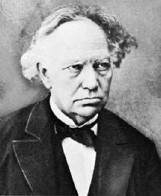

Charles was born with a defect in his right foot, which meant that he moved around only with difficulty. However he had a happy disposition and bore his disability with a cheerful smile.
Charles attended the Collège de Nancy, the Collège Henri, and the Collège Louis-le-Grand. He preferred to read papers by Euler, Gauss and Lagrange rather than work for his formal examinations, but, he was showed remarkable research ability publishing 2 papers while at Louis-le-Grand.
Hermite wanted to study at the École Polytechnique and he took a year preparing for the examinations. He was tutored by Catalan in 1841-42 and passed. After one year at the École Polytechnique, Hermite was refused the right to continue his studies because of his disability. The decision was eventually reversed so that he could continue his studies but strict conditions were imposed. Hermite did not find these conditions acceptable and decided to leave.
Hermite made friends with important mathematicians at this time and frequently visited Joseph Bertrand. On a personal note, he would marry Bertrand's sister. From a mathematical point of view, he began corresponding with Jacobi and he was already producing research which was ranking as a leading world-class mathematician. The letters he exchanged with Jacobi show that Hermite had discovered some differential equations satisfied by theta-functions and he was using Fourier series to study them.
After spending 5 years working towards his degree he took and passed the examinations for the baccalaurèat and licence which he was awarded in 1847. In the following year he was appointed to the École Polytechnique as répétiteur and admissions examiner.
Hermite made important contributions to number theory and algebra, orthogonal polynomials, and elliptic functions. He discovered his most significant mathematical results over the 10 years following his appointment to the École Polytechnique. In 1848 he proved that doubly periodic functions can be represented as quotients of periodic entire functions. In 1849 Hermite submitted a memoir to the Académie des Sciences which applied Cauchy's residue techniques to doubly periodic functions.
Another topic on which Hermite worked and made important contributions was the theory of quadratic forms. This led him to study invariant theory and he found a reciprocity law relating to binary forms. With his understanding of quadratic forms and invariant theory he created a theory of transformations in 1855. His results on this topic provided connections between number theory, theta functions, and the transformations of abelian functions.
In 1856 Hermite was elected to the Académie des Sciences. However he soon after contracted smallpox. Cauchy helped Hermite through the crisis. This had a profound effect on Hermite who, under Cauchy's influence, turned to the Roman Catholic religion.
Although an algebraic equation of the fifth degree cannot be solved in radicals, a result which was proved by Ruffini and Abel, Hermite showed in 1858 that an algebraic equation of the fifth degree could be solved using elliptic functions. He applied these results to number theory, in particular to class number relations of quadratic forms.
In 1862 Hermite was appointed maître de conférence at the École Polytechnique, a position which had been specially created for him. In the 1860's he became first an examiner, then a professor there. Hermite resigned his chair at the École Polytechnique in 1876 but continued to hold the chair at the Sorbonne until he retired in 1897. Poincaré is almost certainly the best known of Hermite's students.
The 1870's saw Hermite return to problems which had interested him earlier in his career such as problems concerning approximation and interpolation. In 1873 Hermite published the first proof that e is a transcendental number. Using methods similar to those of Hermite, Lindemann established in 1882 that π was also transcendental. Hermite is now best known for a number of mathematical entities that bear his name: Hermite polynomials, Hermite's differential equation, Hermite's formula of interpolation and Hermitian matrices.